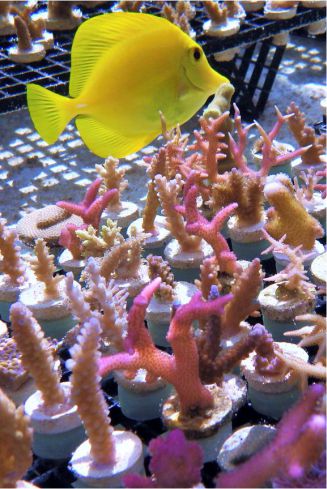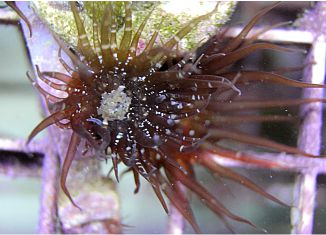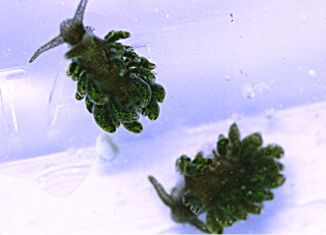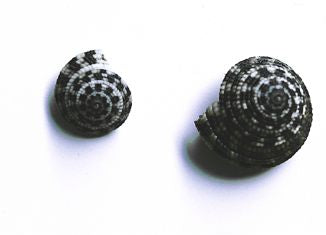Your Cart is Empty

It cannot be stressed enough all new livestock from fish to snails to corals should be quarantined before being added to your display tank. A quarantine period serves many purposes, including making sure your new livestock has recovered from shipping stress, is healthy and eating, and provides an opportunity to check for and remove any potential pest hitchhikers in a controlled environment. This can be a HUGE advantage over trying to eradicate pests once they get into your display tank. But how exactly do you go about this removal, and what sort of animals should you be worried about as pests? Below you will find some tips on dealing with pest animals. This is by no means a comprehensive list, but does cover many of the most common critters that may hitchhike into your tank.
Quarantine every animal before adding to your display tank, regardless of the source!
Carefully examine every animal and identify any pests.
Dipping corals can help reduce unwanted pests.
If you treat for pests please carefully read all product instructions and double check all dosing volumes before adding anything to your tank.
Be obsessive about checking all animals for pests and quarantine everything, dip and treat as needed.
PAY ATTENTION AND BE CAREFUL!!
When handling corals, dips, or medications it is extremely important that you use eye protection and gloves, and wash your hands well with soap after every handling. Many corals produce toxic chemicals that can affect you severely. Please be careful. Seek immediate medical care if you get any irritants in your eyes or ingest any. This is a 911 emergency situation so please take precautions and be serious about handling these animals and never allow children to handle corals. Palytoxin released by zoanthids and palythoas is extremely dangerous, please be careful! Corals and our tanks contain huge numbers of bacteria, some are very pathogenic. It is extremely important that you try to prevent any cuts and if you do experience a cut or puncture wash with soap immediately and use peroxide or another good antiseptic and seek professional medical assistance quickly. Minor cuts or punctures from sharp spiny critters in your tank can and do cause life threatening infections, treat them very seriously and seek medical attention! Folks have lost fingers and limbs and died from such infections so please be alert, serious, and attentive when handling corals and always treat any cuts very seriously!!

Also known as glass anemones, these are small, clear, brown anemones. They are very hardy, reproduce easily in our tanks, and have a strong sting. They also tend to grow out of tiny crevices and to retract quickly, making them difficult to physically remove. If you do go in for physical removal of these pests, be sure to have a siphon ready or perform the procedure outside the tank. Any bits and pieces of ground up anemone that remain in the tank have the potential to regrow, which can end up making your problem worse instead of better!
Should you find Aiptasia in your display tank, there are many natural predators that may be able to help and these natural solutions are often the best approach. True Peppermint Shrimp (Lysmata wurdemanni) will eat them, as will Berghia nudibranchs. Some fish, most notably the Copperband Butterfly, will also eat them if you have an appropriate tank to house one. If you find yourself in a situation where natural predators are not a possibility (or where your infestation is so extreme the predators are going to need some help) there are also some effective chemical solutions, but these should usually be your option of last resort.

Nudibranchs are some of the most commonly seen predatory pests in reef tanks. Most are obligate predators, having a specific type of coral or other animal that is their only food. Often their physical appearance mimics that of their prey, making them hard to spot. In the case of Zoa eating nudis, they commonly have bright coloring that blends right into the skirt on Zoanthids. Thus, the first step in checking for and treating these critters should be to have a close examination of your new Zoanthids, especially while closed when the bright color nudibranchs stand out. Also look for egg coils, usually on the underside or stalk of the Zoanthids and more easily spotted while the Zoas are closed.
Zoanthid Eating
Nudibranch Egg Case
Physical removal is usually your best bet if you do find these Nudibranchs. If your Zoanthids are easily isolated, short freshwater dips can be used to kill adults (no affect on eggs) or help rinse off nudis you are trying to remove. Take care to keep exposure to freshwater short so you do not overly stress your Zoanthids. Wrasses like the yellow coris, melanurus, and many others are also good predators of nudibranchs and other small pests.

Another common Nudibranch is the Montipora eating Nudibranch. These very small, white or cream colored nudis are often very hard to spot and may be more easily identified, at least at first, by the damage they do to your corals. Slowly expanding pale, dead, or dying areas around the edges of your Montipora are a clue that you may need to check for nudis. Check around these edges, as well as in crevices or cracks, and on the underside of the piece and remove any visible adults and eggs. Some dips, like Iodine based dips, are effective against adult nudis but care should be taken with such dips to not overstress your corals. Predatory wrasses may also help to remove adults. In some cases, fragging may be necessary to remove affected portions of a colony to save remaining healthy areas.

These are another very difficult to spot pest. Small tan flatworms that cling to Acropora tissue and can blend in so well they are virtually invisible. Their telltale damage is often the first clue to an infestation, with round ‘bite marks’ of dead tissue appearing, usually at the base of a coral and working upwards. Egg masses may also be found on infested Acroporas. Manual removal is difficult with these critters, and while predatory wrasses may help limit their number they generally do not solve the problem entirely if they get into your main display tank. Your best bet is to find these while your corals are still in quarantine, and dip repeatedly over time until they are eradicated. Many dips have been used successfully, including high dose Flatworm Exit, Levamisole, and Iodine based dips. As always, take care to not over stress your corals when dipping – this is especially true dealing with Acropora!
Miniature red dots crawling around on your Acropora may indicate a ‘red bug’ infestation. The treatment for these is Interceptor – yes, that’s the heartworm treatment you give your dog. If possible treat in a quarantine system, since the medication is largely reef safe but can kill your shrimps and crabs.
Black Bugs
These are yet another pest that can affect Acropora. They appear as small black dots usually at the base of the coral.
Keep a reef tank long enough, and you’ll get worms. Peanut Worms, Spaghetti Worms, Bristle Worms, Fire Worms, Eunicid Worms, Fan Worms, the list of potential worms goes on and on. Many are harmless scavengers or filter feeders. Some, like the bristle worms, are scavengers and thus ‘good worms’ , but not quite so harmless at least to humans. Grab a bristle worm by mistake and you are likely to find many of its bristle are now imbedded in you. Should your tank be overrun with worms, there are natural predators to help. Some wrasses and dotty backs eat bristle worms, as will Arrow Crabs and Coral Banded Shrimp. Manual removal is also effective for reducing worm numbers, especially if you can construct or purchase a simple bristle worm trap. Want another easy tip for reducing scavenger worm numbers? Reduce your tank feeding and siphon out any accumulating detritus. Less food for your scavengers will eventually lead to natural die-off in overpopulation situations.

The variety of crabs, hermits, and shrimps that can hitchhike their way into your tank is incredible. Some are reef safe scavengers, but many are not and will turn out to be aggressive predators. Animals like Mantis Shrimp can make beautiful specimens in dedicated nano tanks but may not be so welcome in a full reef where they may eat their tank mates. In general, the rule ‘It’ s better to be safe than sorry’ will apply to these critters. If you spot a crab that you did not add to the tank intentionally, it’ s probably best to pull it out and, if possible, place in your sump or other easily accessed holding tank until you can determine its aggressiveness and diet. If you have a confirmed problem animal in your tank, you may need to trap it to remove it. Often, a smooth sided glass cup or bottle leaning against your rockwork, with some smelly food in the bottom, is all it takes. Place it near your target's favorite hiding spot and wait overnight. It may take a few tries, but eventually your problem crab will go after the food and be unable to crawl back up the sides of the glass to freedom.
Sign up to get the latest on sales, new releases and more …